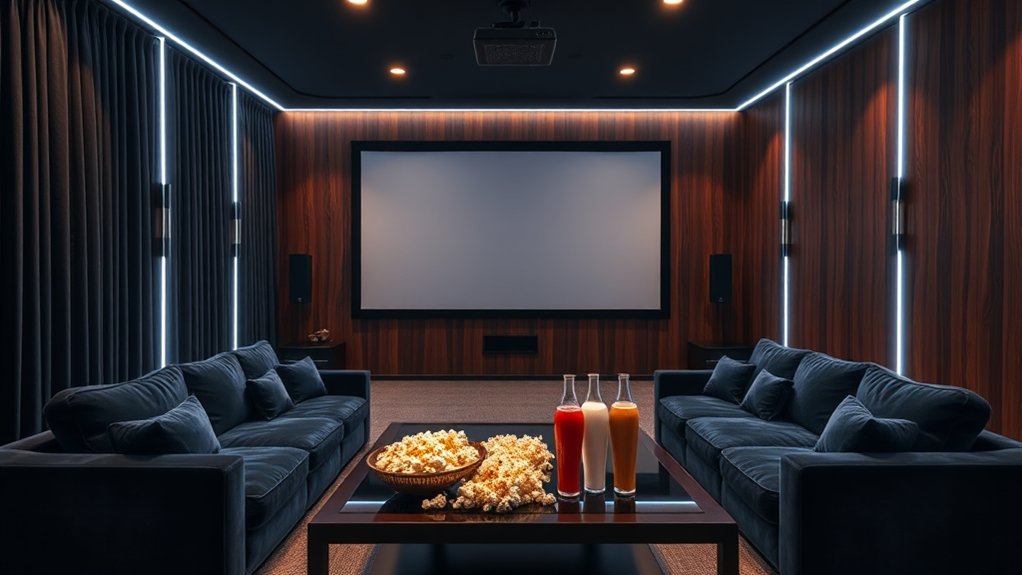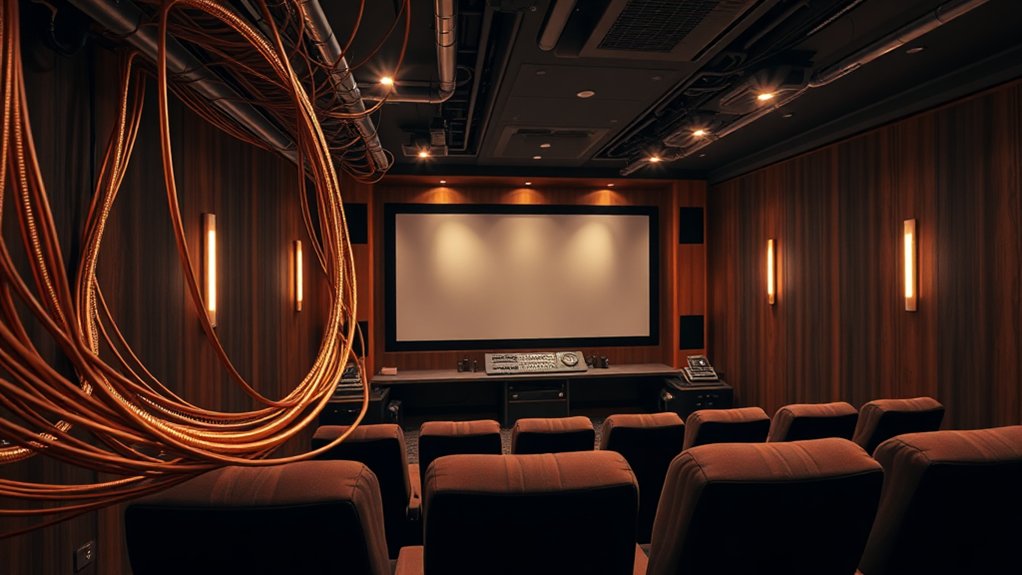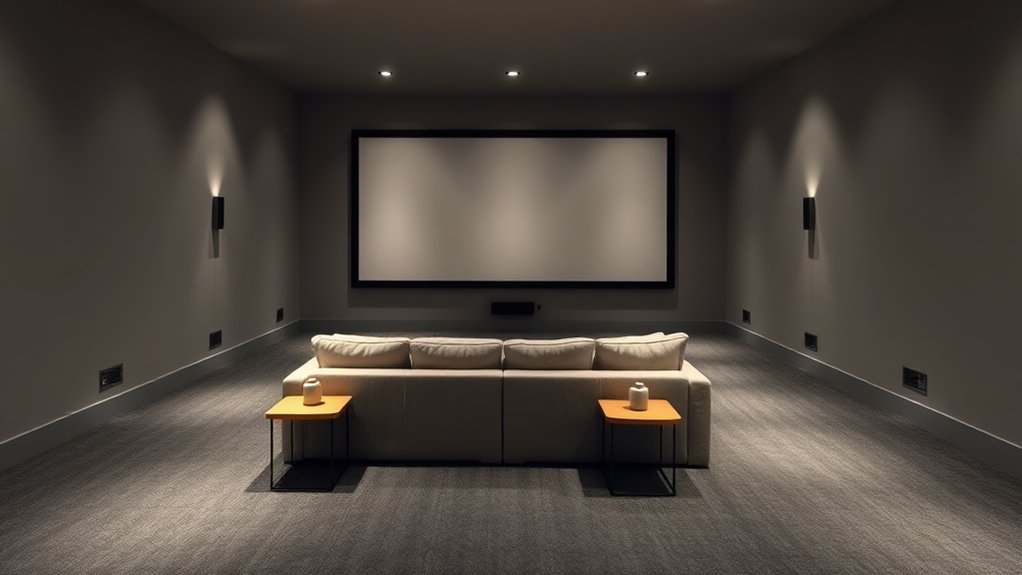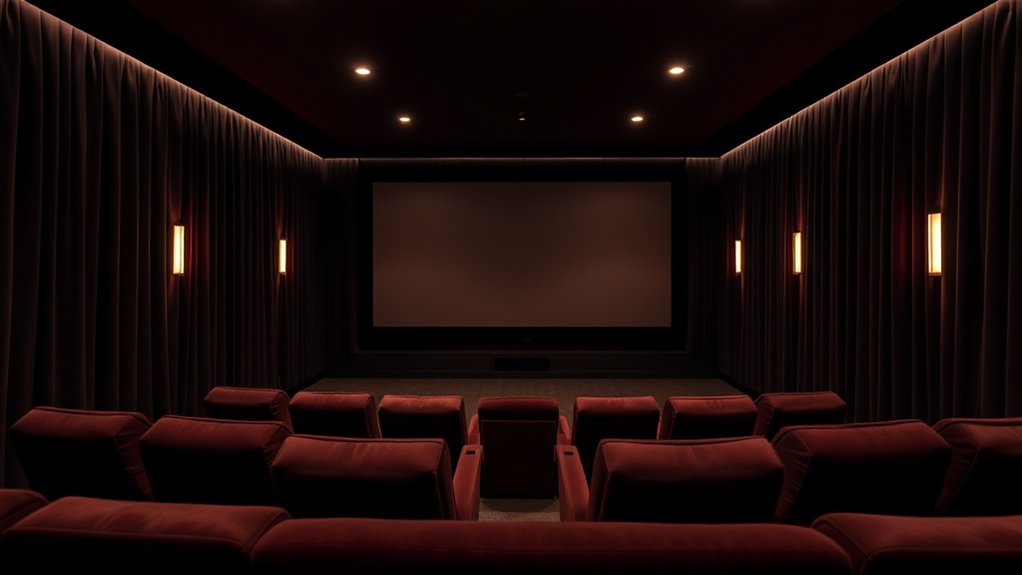To design a home theater room with a projector, start by choosing a high-resolution model, ideally 4K, with at least 3500 lumens for brightness. Position it correctly, ensuring throw distance is considered. Use a rectangular layout for sound and select a 16:9 screen, placing it at eye level. Don’t forget acoustic treatments—like bass traps and panels—and adjust lighting with smart controls to minimize distractions. Want to add the finishing touches? Stick around to find out how!
Key Highlights
- Select a high-resolution projector (ideally 4K) with a minimum brightness of 3500 lumens for optimal viewing in bright rooms.
- Choose a rectangular room layout for effective sound travel and maintain a comfortable distance between the seating and screen.
- Position the screen at eye level (42-48 inches) and consider a fixed frame for a flawless viewing surface.
- Implement sound management techniques with acoustic treatments and high-quality speakers for an immersive audio experience.
- Control ambient light using light-blocking curtains and programmable lighting systems to enhance the viewing environment.
Projector Selection and Placement
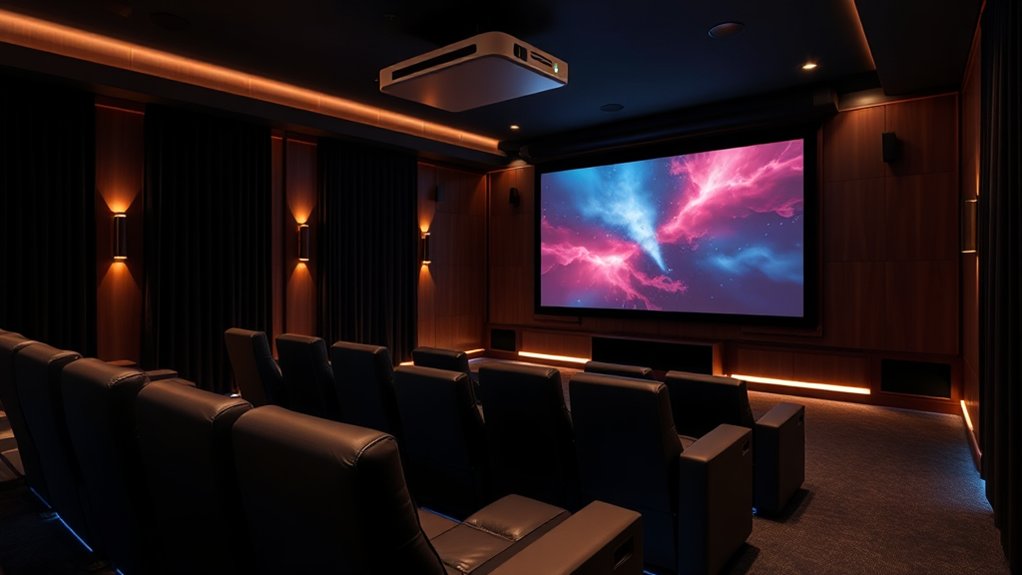
When you’re setting up a home theater, one of the first and most critical decisions you’ll make involves projector selection and placement, since the right projector can improve your viewing experience from ordinary to extraordinary.
You’ll need to weigh resolution options like Full HD or 4K, with 4K providing stunning detail, especially for HDR movies—imagine watching your favorite film in a clarity reminiscent of theater screens.
Brightness is key too; if your room has lots of light, you’ll want a projector that emits at least 3500 lumens to combat glare. Additionally, a projector’s contrast ratio can significantly enhance the visual experience by providing vivid visuals, making it essential to consider in your selection.
Furthermore, to achieve optimal performance, be sure to consider throw distance to ensure your projector sits at the right spot to create the perfect image size—think detective work for ideal placement!
Room Layout and Design Considerations
To create the ultimate home theater experience, you’ll need to pay close attention to room layout and design considerations.
First, aim for a rectangular or square room to guarantee ideal sound travel and flexible seating arrangements. Your dimensions should allow a comfortable distance between the screen and seating, promoting good viewing angles and eye comfort. Additionally, consider investing in high-quality speakers to enhance your audio experience for a truly immersive environment. A dedicated movie room with light-blocking curtains can further enhance the viewing experience by minimizing ambient light distractions.
Don’t forget about ceiling height; it must accommodate your projector without crowding your space. Soundproofing materials like acoustic panels can enhance audio quality, whereas dimmable lighting keeps your screening glare-free.
Finally, be certain to maximize seating layout—maintaining at least 20 inches between rows will make it easier for everyone to enjoy the show without awkward shuffling. After all, isn’t comfort key in home entertainment?
Screen Selection and Positioning
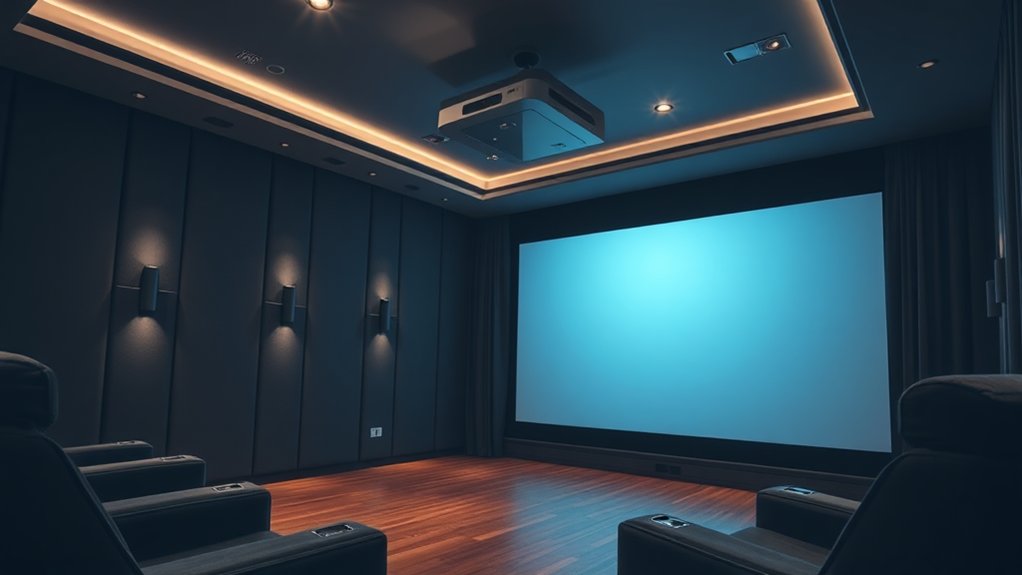
Selecting and positioning the right screen can make or break your home theater experience, so it’s crucial to get it right.
First, consider the common 16:9 aspect ratio for modern content, which is ideal for HDTV and widescreen movies. During a 100-inch screen suits most rooms, think about how far your seats are—ideally between 1.5 to 2.5 times the screen diagonal. You’ll want the screen center at eye level, roughly 42 to 48 inches above the floor, free from obstructions. A fixed frame screen gives a flawless surface, but a pull-down option offers versatility. Additionally, special features like ambient light rejecting screens can significantly enhance your viewing experience in brighter rooms. And let’s not forget, if your room boasts some ambient light, a gray screen might just save your viewing party from being outshined!
Acoustic Treatment and Sound System
Creating an exceptional sound experience in your home theater setup is all about mastering the art of acoustic treatment and sound system arrangement.
You’ll want to use absorption, diffusion, and bass trapping to manage sound reflections and improve clarity. Think of it like a chef balancing flavors—too much of one can ruin the dish!
Placing acoustic panels at primary reflection points, like the side walls and ceiling, helps control echoes, enhancing sound quality.
Don’t forget about those bass traps in the corners; they catch low-frequency buildup, ensuring your favorite movies sound fantastic.
With room correction technology in your receiver, you can smoothly adjust frequencies.
Lighting Control and Electrical Setup
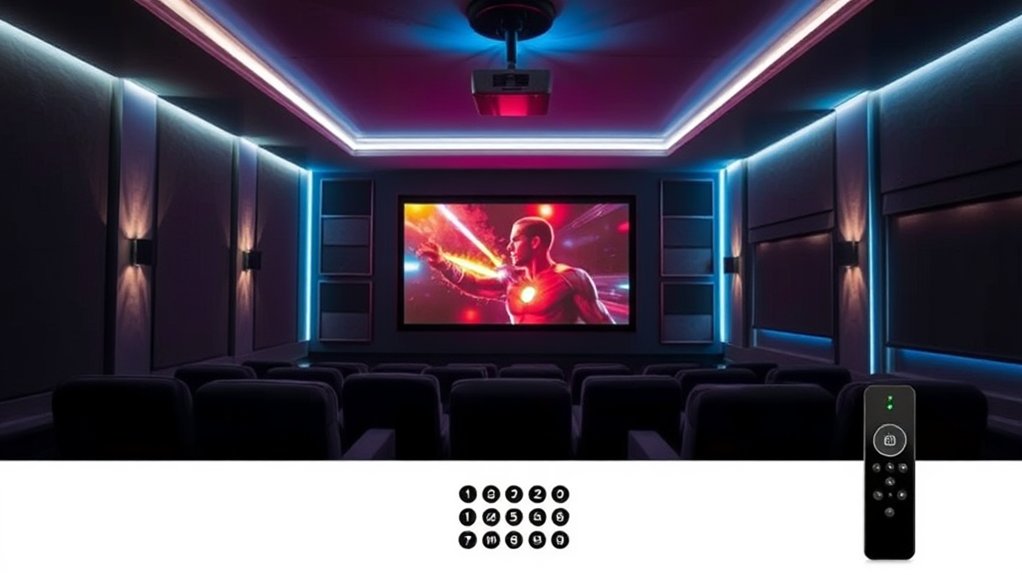
Though you might think of lighting as merely an afterthought in your home theater, it’s actually a critical element that sets the mood and improves your viewing experience.
You’ll want to integrate your lighting control with the projector to guarantee peak light levels while avoiding any interference. Technologies like Lutron’s RTISS can help eliminate annoying distractions, making your audience fully immersed.
Consider a flexible system, such as the GRAFIK Eye 4000, for programmable lighting cues tailored to your specific viewing scenarios.
Explore programmable lighting options like the GRAFIK Eye 4000 to enhance your viewing experience with tailored scenarios.
Additionally, don’t forget about proper electrical setup—use dedicated circuits to avoid noise interference, and commercial-grade outlets for safety.
With thoughtful design, you’ll control the ambiance and elevate the overall enjoyment of your cinematic oasis.
Seating and Comfort
With the right lighting in place, you’re almost ready to truly enjoy your home theater.
Next up is seating, which plays a vital role in your comfort. Aim for at least 36 inches between rows for full recline and easy movement; after all, who wants to squeeze through to grab a snack?
Consider tiered seating with risers for multi-row setups, ensuring that everyone has a clear view. Position your seats 8 to 13 feet from a 65-inch screen for the ideal experience.
And don’t forget those recliners—plush upholstery not only adds comfort but likewise helps absorb sound.
Finally, add 20 inches of aisle space for safe navigation, making it easy to grab those popcorn refills without a tripping hazard!
Frequently Asked Questions
What Is the Best Projector Brand for Home Theaters?
When you’re choosing the best projector brand for home theaters, consider Sony for outstanding picture quality, JVC for authentic visuals, and Hisense for versatile all-in-one solutions. Each offers unique strengths to improve your viewing experience.
How Much Does It Cost to Install a Home Theater?
Installing a home theater can cost between $10,000 and $60,000, depending on size and equipment quality. For a budget option, you might start around $5,000, but extensive setups can exceed $70,000 easily.
Can I Use a Regular Wall as a Projector Screen?
You can use a regular wall as a projector screen, but expect diminished image quality. For casual viewing, it’s fine, but for vivid colors and clarity, a dedicated projector screen’s your best choice.
What Maintenance Do Projectors Require Over Time?
Projectors need regular maintenance, like cleaning the outer casing and air filters, checking ventilation, and replacing lamps when necessary. You should likewise stay updated with firmware to guarantee peak performance and longevity.
How Can I Improve Wi-Fi for Streaming Movies?
To improve Wi-Fi for streaming movies, position your router centrally, limit interference, use wired connections where possible, upgrade your equipment, and test network speeds to guarantee a reliable, high-speed internet connection.

